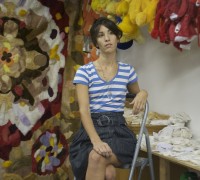Making Art On A Bear Skin Rug
Everyone wants to touch Agustina Woodgate’s hair. Sometimes they touch it out of curiosity. Sometimes they touch, and realizing what it is, they recoil with a shriek of “Ew!” But Woodgate isn’t offended. In fact, she enjoys the different reactions to her work.
The piece in question is Tower, a 3,000-piece structure, created from foam blocks, completely covered in human hair.
The hair is from all ages and ethnicities. Strands of blond covering form the tower window. A band of silver from seniors encircles the top. Look closely and you will notice auburn, chocolate, and jet black tresses that give the tower fascinating dimension and depth.
The various colors come from four years of collecting locks from diverse heads.
“My friends started collecting their hair, and I thought, ‘How funny, I didn’t even ask for it and they’re putting it in envelopes and bags and bringing it over to me,’ so I built a little mobile salon with a wall and wheels, and a chair and a mirror, and I would just set up shop on random corners and I offered free haircuts,” Woodgate said.
Woodgate’s work often begins with collecting things or objects others have discarded —sometimes without even knowing it. In the case of Tower, the idea was a long time coming. She began noticing hair from her shower drain and collected it for a conceptual art project for school. When she began manipulating the hair, Woodgate realized that it could act just like a thread in a sewing machine and completed an assignment in which her own hair took on the form of a mustache, beard and other facial hair, and stood in contrast to an image of her face with a shaved head. But long after the initial project, the idea of hair as something we discard thoughtlessly stayed with Woodgate.
When friends heard she was collecting her own hair for an art project they began bringing home the leftovers from trims at the salon in bags. Sometimes Woodgate would arrive at the studio to find envelopes full of hair shoved under the door.
“A friend of mine cut off his dreadlocks and sent them to me in an envelope,” Woodgate said. “Now I have a responsibility. All these people are going out of their way saving [hair] for me to create this.”
When the foam blocks were wrapped in hair, the real fun of the project began. “Once I had all the bricks done, it was like sitting down and playing Legos for hours and days,” Woodgate said.
The Argentinian-born artist believes in using objects that are already available rather than buying new supplies.
“It’s not like I go and I buy this and I buy the other thing, and now we have another object in the world. It’s the idea of gathering the surplus of things,” she said.
Woodgate’s work with found objects represents a comment on consumerism and pollution. But for Woodgate, simply making a statement is not enough.
“We already know that our world is contaminated,” she said. “We don’t need artists to tell us that we have been contaminating this world. That’s old news. But now, as an artist, how can I find a creative and useful way to gather these materials and assemble them into something else?”
For a recent collection she gathered used teddy bears and worked them into usable rugs. Her inspiration came from thinking about her own teddy bear, Pepe, and the relationship adults maintain with their favorite stuffed animal.
“I am 30-years-old and I still have [my bear],” Woodgate said. “I’m not going to throw it away, but I’m not going to use it either. It’s that crazy relationship as if the object was alive.”
She bought a few teddy bears from a thrift shop and took them apart, realizing as she did that each stuffed bear is composed of several symmetrical pieces of fabric for the arms, legs, and ears.
“So I started playing and all of a sudden I realized that it was like a giant puzzle and the pieces were actually, without cutting them, they were fitting together,” Woodgate said. “So the bears are still bears. They are just being reorganized. If you take apart those rugs, you can build the bears.”
Once again, word about the project got out and donated bears started rolling in. Six enormous teddy bear skin rugs, intended for everyday use in a home, came from the project. Woodgate created several rugs, “Because if there is only one, then it would be an art piece and no one would want to step on it. And the idea is, ‘No. Step on it.’ They were teddy bears. They had a very tough life.”
Woodgate arrived in Miami straight out of college in Buenos Aires and was pleasantly surprised by how much she enjoyed the city. “I thought I was going to feel like an outsider. Miami is home. I have another home in this world: Miami and Buenos Aires.”
Shortly after moving to Miami, Woodgate met another newcomer to the city, a gallery owner named Anthony Spinello.
“He looked at my portfolio, and he’s like, ‘I want to have an exhibition with you.’ He was my first show, and I was his first show. And then from there, a seven-year relationship.” The two have collaborated on art and gallery displays ever since in an unusually harmonious relationship between an artist and her dealer. “We are a team,” Woodgate said. “It’s beyond business. “So that is something really special.”
While Woodgate’s other projects range from drawing hopscotch squares on block after block of city sidewalk to performance art, her work always demands something from her viewers, and provokes us to think about our relationship to our possessions and our spaces — even if the reaction is “Ew!”
For more information on the artist or her artwork please visit www.agustinawoodgate.com or www.spinelloprojects.com


